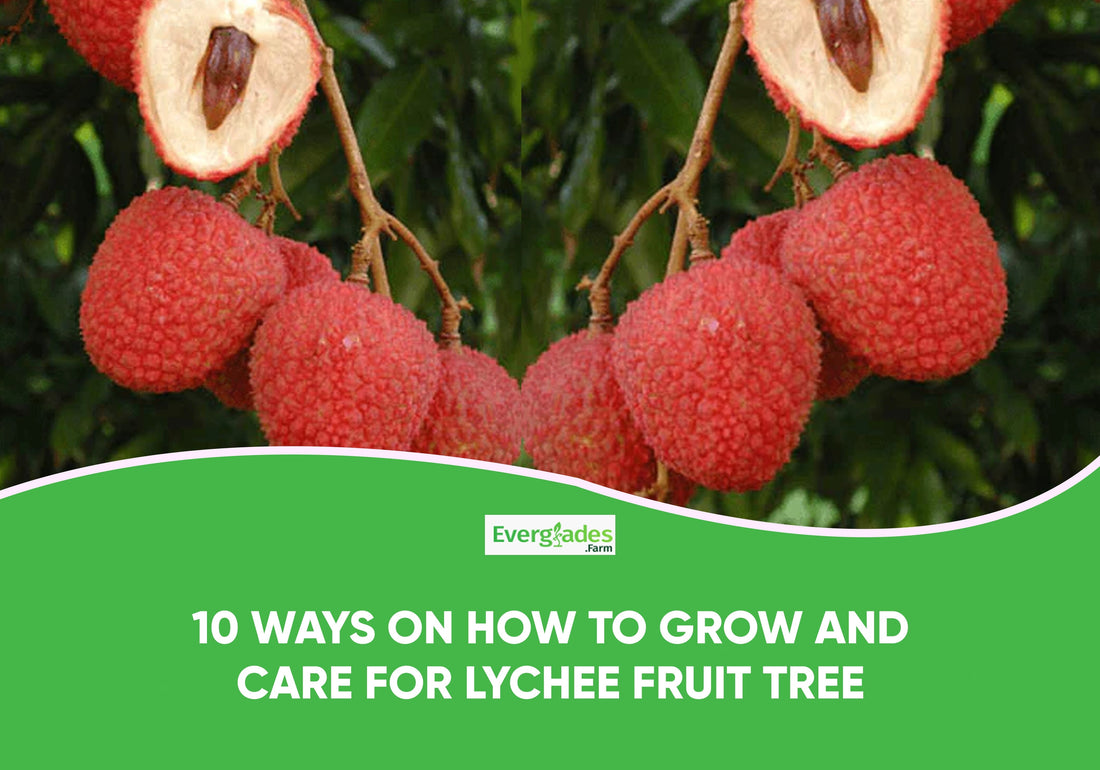
10 Ways On How To Grow And Care For Lychee Fruit Tree
Share

The lychee fruit tree is an attractive tropical plant that produces refreshing, sweet fruit with a floral taste. Lychees have rose-red, bumpy skin hiding translucent white flesh inside. Where does lychee grow? This fruit tree grows in tropical areas of Asia and has become popular in backyards and gardens in warm climates.
Lychee fruit trees can reach 35 feet tall but do best when pruned to around 10 feet for easy care and harvest. Trees grown from seed take 7-10 years to bear substantial tasty fruit in the summer.
You can grow litchi plants from seed, though plants may take up to 10 years to produce fruits. Litchi seeds must first be stratified in the refrigerator for 30 days before being sown to break dormancy.
Here is a detailed guide on how to care for lychee trees in Florida!
Growing a Delicious Lychee Tree in Your Yard

Adding a lychee fruit tree to your landscape allows you to enjoy the sweet, floral flavor of its fruits for years.
Follow key tips for variety selection, planting, watering, and fertilizing when growing these tropical trees.
Pick the Best Lychee Variety
Lychee fruit trees grow best in USDA zones 10-11 with hot summers. When choosing a variety, ensure it tolerates your regional temperatures. ‘Brewster’ withstands cooler climates while ‘Sweetheart’ needs tropical heat. The rosy ‘Mauritius’ lychee bears abundantly.
Plant in a Sunny, Sheltered Area
Lychees require 6-8 hours of direct sun daily so pick an open spot. Shelter from wind helps prevent tattered leaves and broken branches. Locate them away from pools or sprinklers spraying chlorinated water which damages leaves.
Prepare the Soil Thoroughly
Lychee fruit trees thrive in organically rich, well-draining soil with a pH of 6.0-6.5. Dig in compost or well-rotted manure before planting. Create a wide planting hole but avoid going deeper than the root ball. Space trees 15-20 feet apart for air circulation.
Water Regularly for Healthy Growth
New lychee trees need 1-2 inches of water per week during spring and summer for establishment. Utilize drip irrigation or a soaker hose to avoid fungus. Water less in fall and winter, allowing the soil to dry slightly between watering.
Apply Balanced Fertilizer
Feed young lychee trees quarterly from late winter through summer with an organic fruit tree fertilizer. Maintain fertility for maturity but reduce nitrogen pre-harvest so energy goes to the ripening fruit instead of leaves.
Prune for Shape and Airflow
Prune lychee fruit trees when young to encourage proper branching structure and maintain a manageable height under 20 feet. Remove inward-growing limbs and branches that rub together to allow airflow which prevents disease. Cut back long branches invading other trees’ space.
Check Weekly for Pests
Watch closely for tiny red spiders, and eriophyid mites, leaving silver patches on leaves. Apply insecticidal soap immediately before populations explode. Traps help reduce annoying fruit flies during harvest season. Pick up fallen fruits promptly to limit pests.
Prevent Disease with Space and Sanitation
While lychee trees have few disease issues overall, the fungus can occur with poor circulation or excess moisture. Keep lawn irrigation directed away from the tree trunk and foliage. Remove thick growth inside the canopy for breezes. Disinfect pruning tools between cuts with isopropyl alcohol.
Know When Lychees Are Ready to Eat
Lychees tree fruits turn from green to red on the tree when ripe, developing a rosy tan to a deeper hue depending on the variety. Gently squeeze a few fruits. Fragrant ones with a little give are perfect for picking. Use shears without tearing the skin which allows decay organisms to enter.
Protect Roots from Winter Cold
In cooler zones, insulate lychee roots from hard freezes. Mound a 6-8 inch layer of wood chip mulch over the soil out to the dripline after fruiting finishes. Let the mulch compost in place by spring. Wrap trunks of younger trees if extreme cold and wind occurs, using breathable tree wrap.
Grow More Trees from Seed or Cuttings
Propagate new lychee fruit trees from fresh seed, air layers, or grafting for genetic continuity. Collect seeds from your healthiest tree’s fruits. Stratify refrigerated for 30 days before sowing. Maintain even moisture while germinating and protect seedlings from direct sun.
With attentive pruning, pest management, winter care, and propagation techniques, your homegrown lychee tree will fruit deliciously for years to come. Our grafted saplings thrive with proper inputs - browse our wide selection online to add tropical flavor to your landscape.
Conclusion
Are you looking for beautiful lychee trees for sale? We offer a wide selection of attractive, high-quality plants at affordable rates.
You no longer need to pay premium prices for well-maintained plants. We have many plant varieties specially chosen for visual appeal, delicious fruits, and adaptability to local conditions. We pride ourselves on healthy, well-cared-for plants. Everglades Farm is your best choice for lush, affordable plants.
Disclaimer- The information provided in this content is just for educational purposes and is written by a professional writer. Consult us to learn more about growing Lychee plants.
